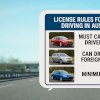Australia, with its breathtaking landscapes, beautiful coastlines, and vibrant cities, is a top destination for tourists. While exploring this diverse country, renting a car and driving on the open road is one of the best ways to experience its beauty. However, driving in Australia for the first time comes with its own set of challenges and rules that you may not be familiar with. From driving on the left side of the road to understanding road signs, here is everything you need to know to make your Australian road trip as smooth as possible.
1. Driving on the Left Side of the Road
One of the first things to remember when driving in Australia is that they drive on the left side of the road. For tourists from countries where driving is on the right, this might be a bit unsettling at first. Be sure to take extra caution when switching from pedestrian areas to roadways and always check for oncoming traffic before making turns.
Key Tip: If you are renting a car, choose one with automatic transmission to reduce the complexity of shifting gears while adapting to the left-side driving.
2. Driver’s License and International Driving Permits
Tourists with a valid overseas driver’s license can drive in Australia for up to three months. Some states may require an International Driver's Permit (IDP), so it’s advisable to check your destination’s requirements beforehand. Always carry both your original license and any required permits while driving.
Key Tip: Make sure your license is in English or is accompanied by a certified English translation to avoid any issues with law enforcement.
3. Road Rules and Speed Limits
Australia has strict traffic laws that all drivers must follow. Be sure to familiarize yourself with the following:
- Speed limits vary by state and location, but generally, 60-100 km/h (37-62 mph) is the range for most roads. Always look out for signs indicating speed limits.
- Seat belts are mandatory for all passengers in the car, regardless of where they are sitting.
- Alcohol limits: The legal blood alcohol concentration (BAC) limit is 0.05% for private drivers, and the penalties for exceeding this limit are severe.
Key Tip: There are significant fines for not adhering to road rules in Australia, especially for speeding or not wearing seat belts.
4. Fuel Stations and Fuel Costs
Fuel stations in Australia are widely available, even in more remote areas. The price of fuel can vary depending on the region, so it’s always a good idea to top up your tank when you're near a gas station. While petrol is the most common type of fuel, some areas also offer diesel options.
Key Tip: Always keep an eye on your fuel gauge, especially if driving in more remote areas where stations may be fewer and further apart.
5. Navigating Roundabouts
Australia uses roundabouts extensively, and they can be confusing for first-time drivers. Always give way to vehicles approaching from the right. Approach the roundabout slowly, and take your exit with caution.
Key Tip: If you’re not sure of the roundabout rules, it’s a good idea to check for signs before entering and yield to any traffic that may be already circulating.
6. Animals on the Road
In rural and remote areas, you may encounter wildlife crossing the roads. Kangaroos, koalas, and emus are commonly spotted in more isolated regions. It's crucial to stay alert, especially during dawn and dusk when animals are more likely to be active.
Key Tip: Reduce your speed and be extra cautious when driving in rural Australia, as animal-related accidents are unfortunately common.
7. Road Signs and Symbols
Australia’s road signs are easy to understand, even for non-English speakers. Warning signs, informative signs, and regulatory signs are common, and they generally follow international standards. The kangaroo crossing sign is one you’ll want to watch out for when traveling through rural areas!
Key Tip: Familiarize yourself with the most common road signs before you drive. Knowing what each symbol means will help you navigate Australian roads confidently.
8. Mobile Phones and Driving
Using a mobile phone while driving is illegal unless you have a hands-free system. If you need to make a call or use GPS, ensure your phone is connected to a hands-free device or pull over safely before using it.
Key Tip: Avoid distractions while driving, and always prioritize safety. There are heavy fines for using your mobile phone while driving.
Conclusion
Driving in Australia for the first time is an unforgettable experience that lets you explore the country's stunning landscapes at your own pace. By understanding the basic road rules, being mindful of local driving customs, and staying alert on the road, you’ll enjoy your trip with peace of mind. Whether you're driving through the city or taking a scenic road trip along the coast, remember to be cautious, follow the rules, and most importantly, have fun!







0 comments for this post